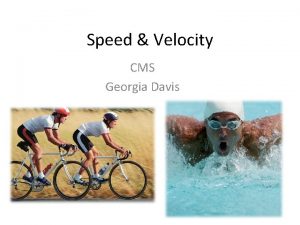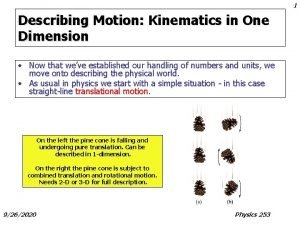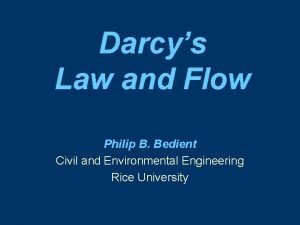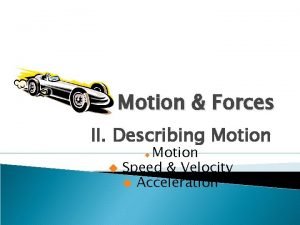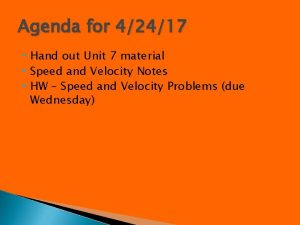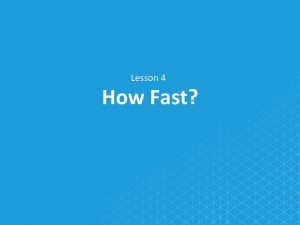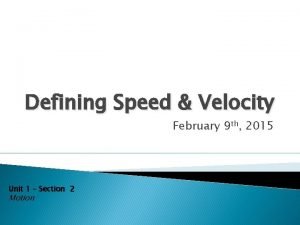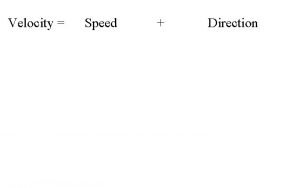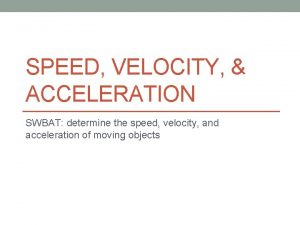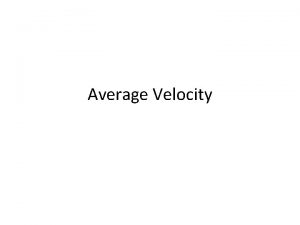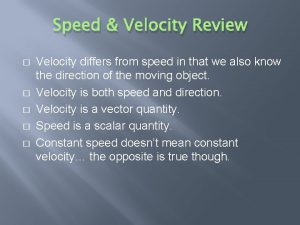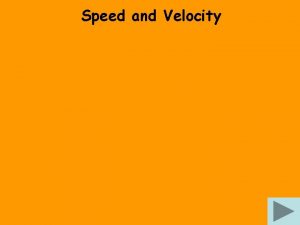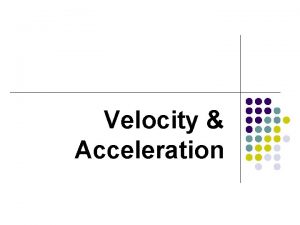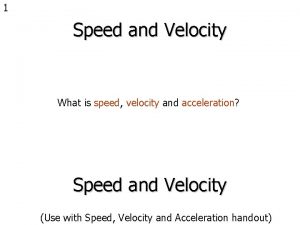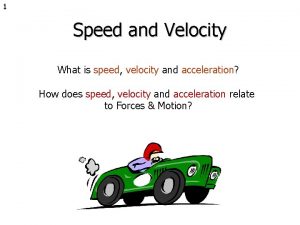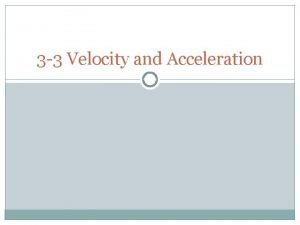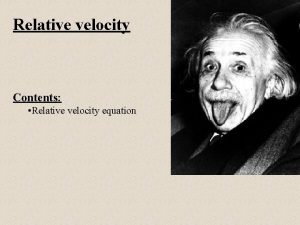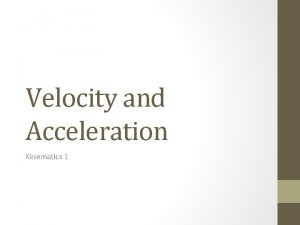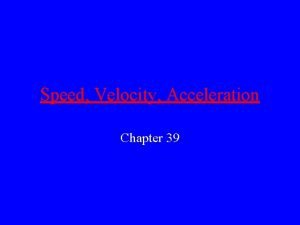Speed Velocity CMS Georgia Davis Speed Speed is
















- Slides: 16

Speed & Velocity CMS Georgia Davis

Speed • Speed is the rate at which an object moves. • To calculate speed you must know the distance and time • The equation for speed is: speed = distance/ time or s = d/t • For example: a cyclist might travel 30 kilometers in 1 hour or 30 km/h • We read the product as 30 kilometers “per” hour.

1. Suppose you walk 10 m down a hallway in 2. 5 s. What is your average speed? Answer: 4 m/s

Average Speed • The speed of most moving objects is not constant. • To calculate average speed we use the equation: Average speed = total distance/ total time • Example: Total distance = 32 km + 13 km Total time = 2 h + 1 h Average speed = 45/3 = 15 km/h

Graphing Speed • Suppose you watched a dog walk beside a fence. • A graph can show the total distance walked in 10 seconds. • The line will not be straight because dogs do not walk at a constant speed.

What is the average speed of the dog? 8 Dog Walk 7 Distance (m) 6 5 4 Series 1 3 2 1 0 1 2 3 4 5 6 Time (s) 7 8 9 10 11

Velocity • Two birds leave the same tree at the same time. They both fly 10 km/h for 5 min but do not end up in the same place. Why not? • They flew in different directions. Both had different velocities. • Velocity is speed plus direction.

Changing Velocity • Velocity changes when speed changes, direction changes, or both changes. Situation What Changes Raindrop falling faster and faster speed Runner going around a turn on a track Car taking an exit off a highway Train arriving at a station Car stopping at a traffic light Baseball caught by catcher Baseball hit by a batter speed & direction

Acceleration • Acceleration is the rate at which velocity changes. • Therefore an object accelerates if the speed (increase or decrease), direction, or both changes.

• An increase in speed is referred to as positive acceleration. • A decrease in speed is referred to as negative acceleration or DECELERATION. • An object traveling at a constant speed accelerates if it changes direction.

Accelerating? • • • Car traveling at constant speed of 65 mi/h. Runner rounding a turn. Baseball pitched. Stopping for school bus. Swerving to miss a dog in road. Riding the Ferris wheel at the county fair.

Calculating Acceleration • Acceleration = Final speed – Initial speed Time Speed’s unit is m/s & time’s unit is seconds. Acceleration is change in speed/ time, therefore the unit is m/s/s or just m/s 2

You try… • An airplane accelerates on a runway to 40 m/s after 5 seconds. What is the acceleration?

• As a roller coaster car starts down a slope, its speed is 4 m/s. But 3 seconds later, at the bottom, its speed is 22 m/s. What is its average acceleration? • 22 m/s - 4 m/s 3 s • 18/3 = 6 m/s 2

Slope =Rise/Run 4 m/s 2 s = 2 m/s 2

Fill in the graphic organizer for a car that starts from one stop sign and approaches the next stop sign. Use the following terms: velocity, positive acceleration, deceleration, and at rest.
 Velocity cms
Velocity cms Initial velocity and final velocity formula
Initial velocity and final velocity formula The law of universal gravitation states that
The law of universal gravitation states that Linear to angular velocity
Linear to angular velocity Instantaneous velocity vs average velocity
Instantaneous velocity vs average velocity Initial velocity and final velocity formula
Initial velocity and final velocity formula Darcy's law
Darcy's law Is v final velocity
Is v final velocity Tangential speed
Tangential speed Permeability formula
Permeability formula Acceleration
Acceleration Difference between speed and velocity
Difference between speed and velocity Speed and velocity
Speed and velocity Velocity v speed
Velocity v speed Speed and velocity
Speed and velocity Reference point examples
Reference point examples Speed vs velocity
Speed vs velocity
